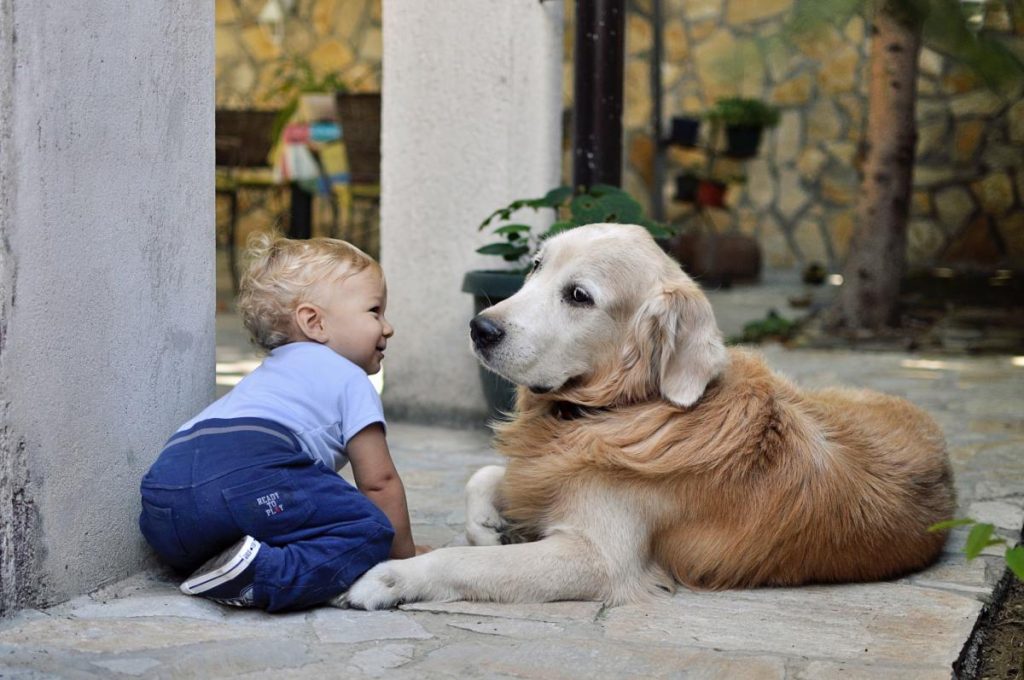
Teaching children to be gentle and kind with dogs is an important lesson that can help foster a positive and safe relationship between them. Dogs are wonderful companions, but it’s crucial for children to understand that dogs have their own needs, boundaries, and emotions. In this guide, we will provide a detailed description of effective strategies and techniques to teach children to be gentle and kind with dogs.

- Education and Understanding: The first step in teaching children to be gentle and kind with dogs is to educate them about dogs’ behavior, body language, and needs. Explain that dogs have feelings, just like humans, and that they can feel pain, fear, and stress. Teach them to recognize signs of a happy, relaxed dog (loose body, wagging tail) versus signs of fear or discomfort (tucked tail, ears back). Encourage them to always approach dogs cautiously and respectfully.
- Lead by Example: Children learn by observing and imitating the behavior of adults. Model gentle behavior towards dogs by treating them with kindness, respect, and empathy. Show children how to pet dogs gently and avoid rough play or aggressive behavior. By setting a positive example, children will understand the importance of being gentle and kind to animals.
- Supervised Interactions: Always supervise interactions between children and dogs, especially when they are young or unfamiliar with each other. This ensures the safety of both the child and the dog. Supervision allows you to intervene and redirect inappropriate behavior or teach children how to interact appropriately with dogs.
- Teach Proper Approaching and Petting: Teach children the correct way to approach a dog. Instruct them to ask for permission from the dog’s owner and approach slowly, allowing the dog to approach them if comfortable. Show them how to extend a closed hand for the dog to sniff, rather than reaching over their head. Teach children to avoid sudden movements and to pet the dog gently, using slow strokes. Remind them to avoid sensitive areas like the face or tail.
- Boundaries and Consent: Teach children to respect a dog’s boundaries and personal space. Explain that not all dogs enjoy being hugged, kissed, or picked up, and it’s important to ask for the dog’s consent before doing so. Encourage children to observe the dog’s body language and respond accordingly. If the dog shows signs of discomfort, teach them to give the dog space and allow it to retreat if needed.
- Encourage Gentle Play: Teach children to engage in gentle play with dogs. Discourage chasing, pulling, or rough play, as it can lead to fear or aggression. Instead, encourage them to play with toys or engage in activities that promote positive interaction, such as fetch or hide-and-seek. By promoting gentle play, children learn to respect the dog’s boundaries while still enjoying their time together.
- Positive Reinforcement: Use positive reinforcement to reward children for gentle and kind behavior towards dogs. Praise and acknowledge them when they show empathy, gentle petting, or appropriate play. This positive feedback encourages children to continue exhibiting gentle behavior and reinforces the importance of treating dogs with kindness.
- Communication and Listening Skills: Teach children the importance of communication and listening when interacting with dogs. Help them understand that dogs communicate through body language and vocal cues. Encourage them to pay attention to the signals dogs give and respond accordingly. Teach them that if a dog shows signs of fear or discomfort, it’s crucial to stop what they are doing and give the dog space.
- Teach Responsibility: Teaching children to be gentle and kind with dogs also involves teaching responsibility. This includes teaching them how to care for dogs, such as feeding, grooming, and walking. By involving children in the dog’s daily care, they develop a sense of empathy and understand the importance of meeting the dog’s needs.
- Continuous Supervision and Reinforcement: Remember that teaching children to be gentle and kind with dogs is an ongoing process. Revisit the lessons regularly and provide constant supervision and reinforcement. As children grow, their understanding of dogs’ needs and emotions will deepen, further enhancing their ability to be gentle and kind.

In conclusion, teaching children to be gentle and kind with dogs is crucial for fostering a positive and safe relationship. By educating children about dogs’ behavior and needs, leading by example, and teaching proper approaching, petting, and play, we can instill empathy, respect, and kindness in children. Continuous supervision and reinforcement, along with positive reinforcement, will help children develop a lifelong understanding and bond with dogs based on gentle and kind interactions.
